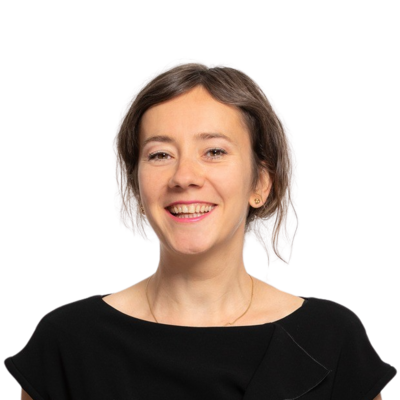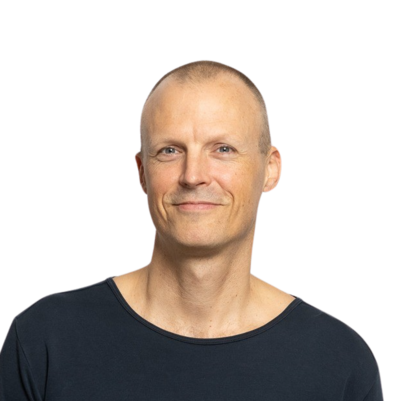
Art in the office context - a dialogue full of surprises
In his work, Berlin-based artist Matthias Bitzer combines drawing, painting and sculpture to create an experiential space that explores history and identity. We asked him about our collaboration after he installed numerous artworks and interventions in our offices in 2022.
undconsorten: Dear Matthias, what happens when art is exhibited in an office - what does this targeted intervention by artists in the workspace create?
Matthias Bitzer: Offices are clearly designed to be functional. And you actually spend quite a lot of time there at work and on the side. For me, it is particularly interesting to think about the psychology, the spaces, also to bring people back to the office from their home office. I don't want to install distractions or dominate these spaces, but rather try to incorporate a kind of scenography, where there could also be a certain context within the works and therefore a certain flow in the space that you can follow if you want to - or not.
The idea of freeing the workspace from its barrenness and, in the best case, filling it with inspiring things has a positive effect on the well-being of the people who work there.
&co: If you look at what you recently did in our office on Kurfürstendamm, it really is a total work of art.
MB: I can certainly relate to the term. There are no general solutions. I don't go in there like an interior designer or anything like that, but I do try to implant something coherent into these spaces.
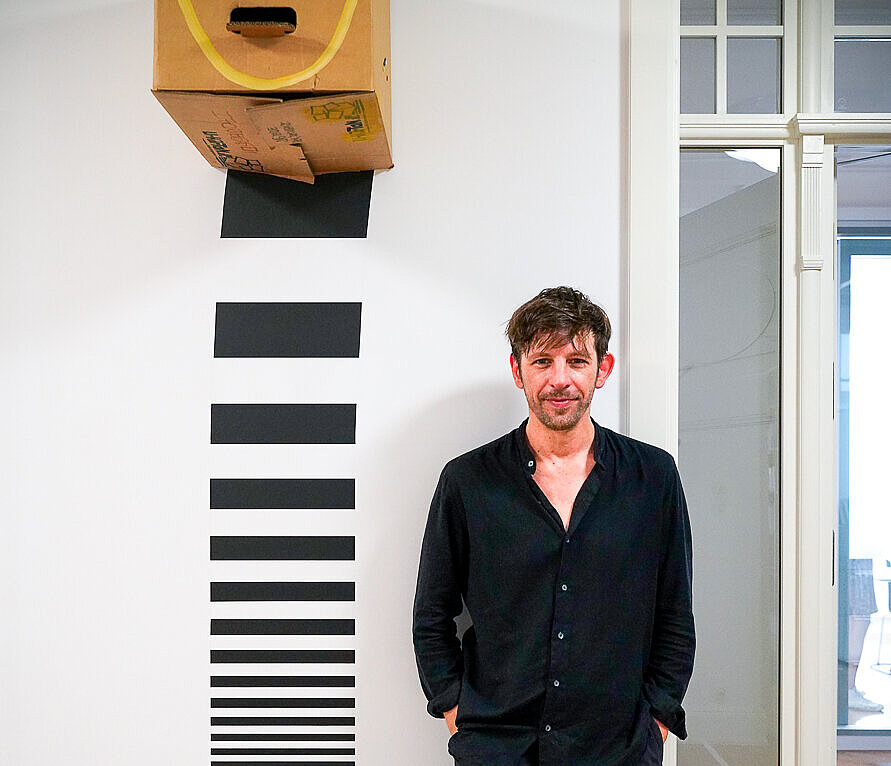
&co: Matthias, can you give examples of your approach? What did you have in mind in connection with the room in question?
MB: Of course, I take a close look at the rooms in advance in order to first of all respond to the existing architecture. Then I really wanted to disrupt this rotunda, this oval, and so I went straight for these Doric columns. They were certainly not part of the original architecture. I used simple black and white lines to create a basic structure that connects the different works with each other, even across rooms, and then incorporated these structures into the works themselves.
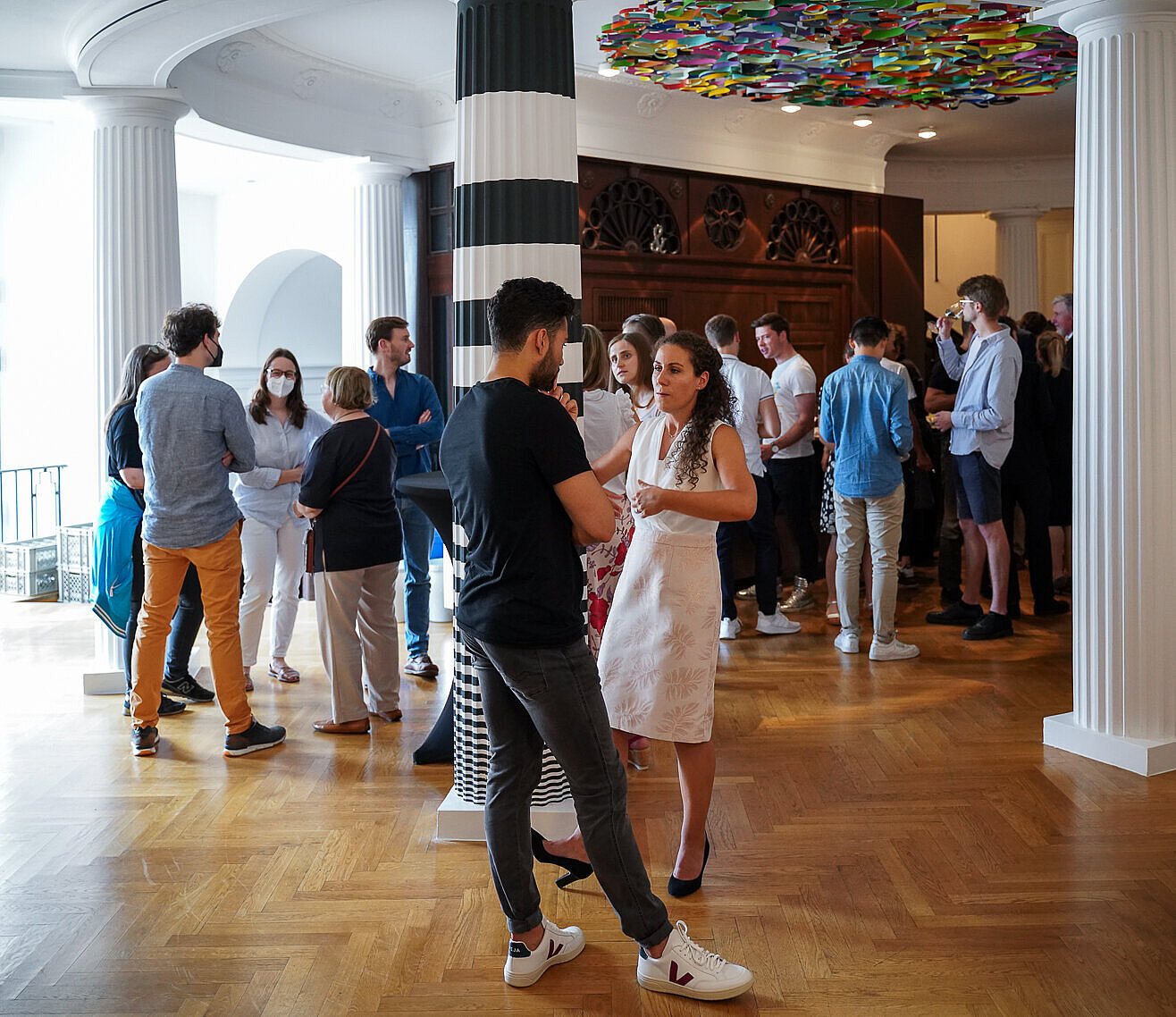
Then there's this cloud room. There were already children's toys etc. in there. That's why I thought I could shake this room up a bit. The usability of this room, which was perhaps previously neutral, will probably be somewhat restricted. Of course, I realised that this would have quite an impact on the working atmosphere. But the process also happened in constant dialogue with you. After all, none of the concepts for these rooms had been finalised beforehand. My work then weaves itself directly into what I found.
&co: But you rely on your intuition, don't you?

MB: Exactly. After all, intuition is nothing other than the right memories and experiences that have been recorded. And there are features in spaces that particularly appeal to me. Basically, when I install art somewhere, I try to break the habits of those who are constantly moving around there. My basic hope was that everyone would be happy with it.
That requires a bit of empathy. Of course, I can't go into detail about the individual people because I usually don't know them. But with Jens [Müller-Oerlinghausen], for example, the knife hanging from the ceiling with just the tip attached to a magnet is of course very special for him. It's a warning of the times.
&co: Were these interventions that you recognise later, that you look at by chance and think: Wait a minute, there's something there, is that art, was it there before?
MB: Basically, as an artist, I want to increase a more attentive awareness of our present. And I think that's absolutely necessary in order to somehow come to terms with this present that is flooded with information. And then in spaces like your offices, it lends itself to using precisely these "useless" spaces for the time being. I could imagine that if you're dealing with certain problems and perhaps not getting anywhere, when you suddenly realise things like this, you might have an empty head again and then you can start all over again.

I always find the interruption, which also makes me smile, a very welcome change from the everyday.
&co: The door to the passageway to the back of our office has seals in a zebra pattern. Did you have a hand in that too?
MB: I had a hand in that too. (laughs)
&co: That's brilliant, because at some point you might stop and wonder. It's not in-your-face, it's so subtle that it kind of follows you around. We realised this months ago and thought about it again and again, and the question has been burning under our nails ever since.
MB: Wonderful. That's actually a prime example of exactly what I wanted to provoke. You hang a picture on the wall and then it's clearly also a foreign object. And sometimes I work with painted frames that also have a zebra pattern in order to assert that the boundary to the outside world and the picture inside is perforated, so to speak.

So the world is allowed to flow into this image just as much as this image is allowed to flow into the surroundings. Part of my intention is that the viewers or participants of such an installation may overlook this boundary at first, but at some point realise it in the logical sequence. And then behind it all there is suddenly the assertion of an intention.
And at that moment, I think our awareness sharpens. Perhaps this heightened awareness can also be taken out of the office and into the world. Perhaps elsewhere you can recognise the "connecting elements" with which the world is sometimes put together.
&co: Irritation and provocation are fixed elements of art. Why are they valuable contributions in the work context?
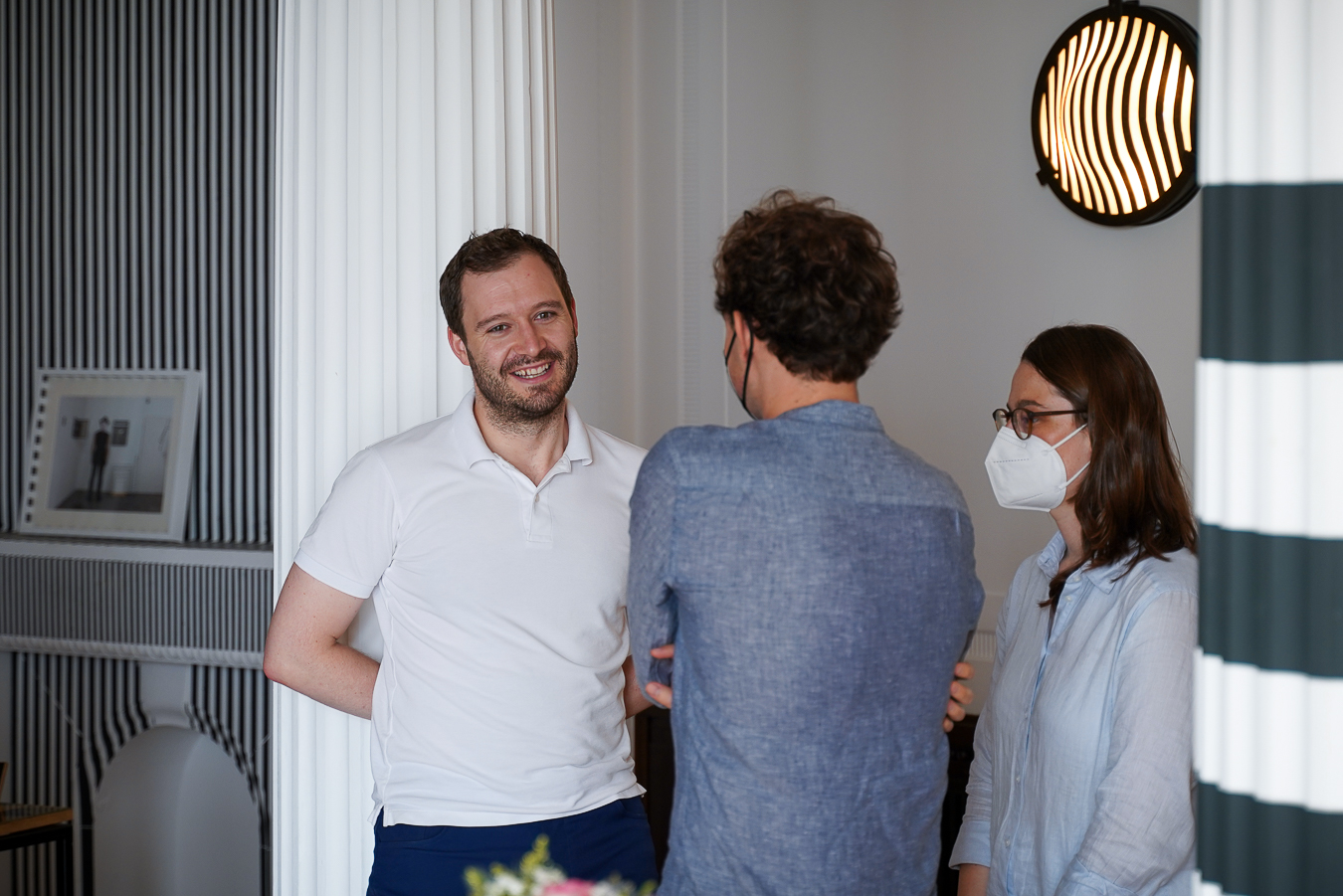
MB: I think everything that tickles a certain doubt leaves a trace somewhere and you then look at the whole thing differently again. Such a small loss of attention can certainly lead to a new analysis of what you see. And such a new process of thinking can rub off on all the other processes that are taking place at that moment.
&co: So the "business case: what does art do for my organisation?" could be summarised as follows:
- On the one hand, I'm happier because our office is nicer. I enjoy going to the office.
- The second function of art is to give my brain a little break from time to time in order to refocus.
- Third function: sharpened perception, taking a closer look, mindfulness.
What else would you add to this list?
MB: Sensitisation to the environment in which you find yourself. Marcel Proust once said: "Think of my work as a pair of glasses, use them, wear them, and if they suit you and if you can see more with them, then keep them.
&co: What do you think about uniform measures such as a clean desk policy?
MB: I'm getting into a field where I'm not really competent. But my basic feeling would be that the clean desk policy should be declared obsolete and people should be given the opportunity to set up their own individual workplace. If that goes wrong, you can change it again. I just wouldn't necessarily mix art and individual desks. Because art shies away from democracy, and that's a good thing. The art should perhaps not be chosen by a majority decision, whereas my feeling would be to furnish your own workspace individually.
In your case, it would be perfectly possible to say: Look, this is the archive of the art we've bought. Perhaps there are works that are of particular interest to certain employees and then they could say: I would like to have that in the office, would that be possible? If a company is interested in discussing such a topic, then I think that would be a great opportunity: in this way, the works rotate within the office and it changes all by itself and everyone has the feeling that they can participate.
&co: So a connecting element and a bit of participation.
MB: Exactly. And perhaps also for team building. Not just simply showing it, but perhaps briefly explaining why you would like it. It wouldn't be the first time that a tiptop discussion has arisen because of art.
&co: Did you have any reflections about us during your tour here, for example? What does your exhibition actually do to us consultants?
MB: I definitely had the feeling that everyone was very interested and that it was also welcomed. That was very reassuring, I have to say. There were also good questions, which was really very pleasant.
&co: Did you have the impression with us that it was a different audience to the one you know from the typical gallery context?
MB: It's hard to say. You can't compare it to a museum. What came through in any case was that those who took part in the tour had a broader interest in the art itself and definitely took the opportunity to talk to me.
&co: Our workspaces are rather nomadic, so we change rooms. To what extent can art help us to feel at home for a short time or perhaps create a sense of home?

MB: I guess that's impossible. So somehow it means something different for everyone who works there.
&co: Well, some people deliberately sit in certain rooms a lot, and that also has to do with the art.
MB: That would of course be interesting to find out. That would be an interesting question to ask the staff. I believe that as soon as someone thinks about it, a few reasons will come up very quickly. And depending on how a survey like this turns out, you can also consider whether the clean desk policy should perhaps be restricted a little.
&co: Who would have thought that art and business could be so fruitful?
MB: I also find it thoroughly interesting and very helpful to hear your position on this. These are important questions about the relevance and usefulness of art in everyday working life. These are absolutely important questions for me. Art must also open up in this respect.

There is so much art, there are now so many markets, so many galleries - but what is really missing out is a social mission that art should fulfil. And it doesn't necessarily have to be politically or otherwise charged. It's simply about tangible questions such as: What's the point? How does art find its way to people?
And most people spend most of their time at work. When companies open up to inviting someone like me - it's not that often that an artist is given carte blanche - then I think that's also something that can be seen as an aspect of a social mission.
&co: The exchange between you as an artist and us as beneficiaries is a process that is both conscious (on your part) and subconscious on our part in everyday life. What do you think about the transition between the conscious and the unconscious?
MB: One is there, but you don't realise it, and you know that the other is there. Consciousness only grows when it is addressed, when it is exposed to stimuli. If art can provide such stimuli, then I think that's great.
&co: Perhaps it is enriching that we have a dialogue between the conscious and the subconscious.
MB: Absolutely. Every expansion of consciousness, even the most minimal, is good for you and also has a positive effect on how you feel. I feel it is my responsibility to ensure that the traces I lay out there also lead to a logical concept. In other words, that it is not just a small disruptive element that is simply intended to distract. If you discover one thing, then sooner or later you will notice a second object and a third and a fourth. And then a chain closes.
This includes, for example, looking in unconventional places and thinking unconventionally. Simply going off the grid, blocking the opportunity, shifting the focus. Sometimes you find yourself in the middle of chaos simply because you're either too close or too far away - and that affects our entire perception.
&co: And it's basically an exercise in dialogue and listening. We listen to you without knowing you or without actively thinking about the fact that you are behind it. It's a bit like a message in a bottle: we learn - as you say - to read the clues that you have laid out and also to sharpen our train of thought.
MB: Yes, in the best case that happens. That would be great.
&co: Dear Matthias, thank you very much for the interesting conversation.

